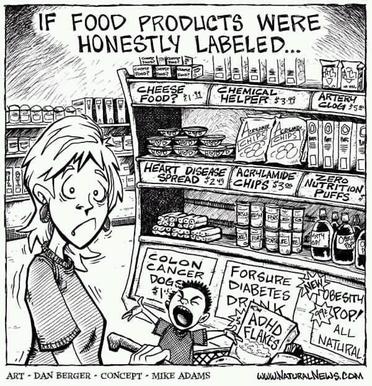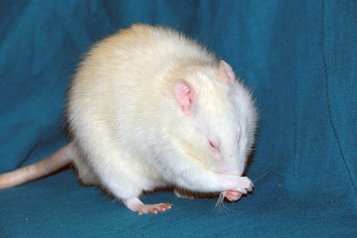MSG FACTS (MONOSODIUM GLUTAMATE)
At the bottom of this page you will see the link to Truth In Labeling site. Please visit their site for much more insight on the
detriments of MSG and MSG bi-products. Also you will find their phone number, they welcome any calls for questions.
detriments of MSG and MSG bi-products. Also you will find their phone number, they welcome any calls for questions.
What is Monosodium Glutamate? Click HERE. What is MSG? Click HERE. Why is 'Hiding" MSG so important? Click HERE.
Everyone knows that some people get reactions after eating the food ingredient monosodium glutamate --reactions that include migraine headaches, upset stomach, fuzzy thinking, diarrhea, heart irregularities, asthma, and/or mood swings. What many don’t know, is that more than 40 different ingredients contain the chemical in monosodium glutamate (processed free glutamic acid) that causes these reactions. The following list of ingredients that contain processed free glutamic acid has been compiled over the last 20 years from consumers’ reports of adverse reactions and information provided by manufacturers and food technologists.
_______________________________________________________________________________________________________________________________________________________
|
Names of ingredients that always contain
processed free glutamic acid: Glutamic acid (E 620)2, Glutamate (E 620) Monosodium glutamate (E 621) Monopotassium glutamate (E 622) Calcium glutamate (E 623) Monoammonium glutamate (E 624) Magnesium glutamate (E 625) Natrium glutamate Yeast extract Anything “hydrolyzed” Any “hydrolyzedprotein” Calcium caseinate, Sodium caseinate Yeast food, Yeast nutrient Autolyzed yeast Gelatin Textured protein Soy protein, soy protein concentrate Soy protein isolate Whey protein, whey protein concentrate Whey protein isolate Anything “…protein” Vetsin Ajinomoto |
Names of ingredients that often contain or
produce processed free glutamic acid: Carrageenan (E 407) Bouillon and broth Stock Any “flavors” or “flavoring” Maltodextrin Citric acid, Citrate (E 330) Anything“ultra-pasteurized” Barley malt Pectin (E 440) Protease Anything “enzyme modified” Anything containing“enzymes” Malt extract Soy sauce Soy sauce extract Anything “protein fortified” Anything “fermented” Seasonings (unless 100% Organic) (1) Glutamic acid found in unadulterated protein does not cause adverse reactions. To cause adverse reactions, the glutamic acid must have been processed/ manufactured or come from protein that has been fermented. |
The following are ingredients suspected of containing or creating sufficient processed free glutamic acid to serve as MSG-reaction triggers in HIGHLY SENSITIVE people:
Corn starch Corn syrup Modified food starch Lipolyzed butter fat Dextrose Rice syrup Brown rice syrup Milk powder Reduced fat milk (skim; 1%; 2%) most things low fat or no fat anything Enriched anything Vitamin enriched (2) E numbers are use in Europe in place of food additive names. |
_______________________________________________________________________________________________________________________________________________________
The following work synergistically with MSG to enhance flavor. If they are present for flavoring, so is MSG.
Disodium 5’-guanylate (E 627) Disodium 5’-inosinate (E-631) Disodium 5'-ribonucleotides (E 635)
Disodium 5’-guanylate (E 627) Disodium 5’-inosinate (E-631) Disodium 5'-ribonucleotides (E 635)
Reminders
Low fat and no fat milk products often contain milk solids that contain MSG and many dairy products contain carrageenan, guar gum, and/or locust bean gum. Low fat and no fat versions of ice cream and cheese may not be as obvious as yogurt, milk, cream, cream
cheese, cottage cheese, etc., but they are not exceptions.
Protein powders contain glutamic acid, which, invariably, will be processed free glutamic acid (MSG). Individual amino acids are not always listed on labels of protein powders.
At present there is an FDA requirement to include the protein source when listing hydrolyzed protein products on labels of processed foods. Examples are hydrolyzed soy protein, hydrolyzed wheat protein, hydrolyzed pea protein, hydrolyzed whey protein, hydrolyzed, corn protein. If a tomato, for example, were whole, it would be identified as a tomato. Calling an ingredient tomato protein indicates that the
tomato has been hydrolyzed, at least in part, and that processed free glutamic acid (MSG) is present.
Disodium guanylate and disodium inosinate are relatively expensive food additives that work synergistically with inexpensive MSG. Their use
suggests that the product has MSG in it. They would probably not be used as food additives if there were no MSG present.
MSG reactions have been reported from soaps, shampoos, hair conditioners, and cosmetics, where MSG is hidden in ingredients with names that include the words "hydrolyzed," "amino acids," and/or "protein."Most sun block creams and insect repellents also contain MSG.
Drinks, candy, and chewing gum are potential sources of hidden MSG and/or aspartame, neotame. and AminoSweet (the
new name for aspartame). Aspartic acid, found in neotame, aspartame (NutraSweet), and AminoSweet, ordinarily causes MSG type reactions
in MSG sensitive people. (It would appear that calling aspartame "AminoSweet" is industry's method of choice for hiding aspartame.) We have not seen Neotame used widely in the United States.
Aspartame will be found in some medications, including children's medications. For questions about the ingredients in pharmaceuticals, check with your pharmacist and/or read the product inserts for the names of “other” or “inert” ingredients.
Binders and fillers for medications, nutrients, and supplements, both prescription and non-prescription, enteral feeding materials, and
some fluids administered intravenously in hospitals, may contain MSG.
According to the manufacturer, Varivax–Merck chicken pox vaccine (Varicella Virus Live), contains L-monosodium glutamate and hydrolyzed gelatin, both of which contain processed free glutamic acid (MSG) which causes brain lesions in young laboratory animals, and causes endocrine disturbances like OBESITY and REPRODUCTIVE disorders later in life. It would appear that most, if not all, live virus vaccines contain some ingredient(s) that contains MSG.
Reactions to MSG are dose related, i.e., some people react to even very small amounts. MSG-induced reactions may occur immediately after ingestion or after as much as 48 hours. The time lapse between ingestion and reaction is typically the same each time for a particular individual who ingests an amount of MSG that exceeds his or her individual tolerance level.
Remember: By food industry definition, all MSG is "naturally occurring." "Natural" doesn't mean "safe." "Natural" only means that the ingredient started out in nature, like arsenic and hydrochloric acid.
______________________________________________________________________________________________________________________________________________________
Information provided by the Truth in Labeling Campaign
Web: www.truthinlabeling.org Phone: 858-481-9333.
e-mail: adandjack@aol.com.
Low fat and no fat milk products often contain milk solids that contain MSG and many dairy products contain carrageenan, guar gum, and/or locust bean gum. Low fat and no fat versions of ice cream and cheese may not be as obvious as yogurt, milk, cream, cream
cheese, cottage cheese, etc., but they are not exceptions.
Protein powders contain glutamic acid, which, invariably, will be processed free glutamic acid (MSG). Individual amino acids are not always listed on labels of protein powders.
At present there is an FDA requirement to include the protein source when listing hydrolyzed protein products on labels of processed foods. Examples are hydrolyzed soy protein, hydrolyzed wheat protein, hydrolyzed pea protein, hydrolyzed whey protein, hydrolyzed, corn protein. If a tomato, for example, were whole, it would be identified as a tomato. Calling an ingredient tomato protein indicates that the
tomato has been hydrolyzed, at least in part, and that processed free glutamic acid (MSG) is present.
Disodium guanylate and disodium inosinate are relatively expensive food additives that work synergistically with inexpensive MSG. Their use
suggests that the product has MSG in it. They would probably not be used as food additives if there were no MSG present.
MSG reactions have been reported from soaps, shampoos, hair conditioners, and cosmetics, where MSG is hidden in ingredients with names that include the words "hydrolyzed," "amino acids," and/or "protein."Most sun block creams and insect repellents also contain MSG.
Drinks, candy, and chewing gum are potential sources of hidden MSG and/or aspartame, neotame. and AminoSweet (the
new name for aspartame). Aspartic acid, found in neotame, aspartame (NutraSweet), and AminoSweet, ordinarily causes MSG type reactions
in MSG sensitive people. (It would appear that calling aspartame "AminoSweet" is industry's method of choice for hiding aspartame.) We have not seen Neotame used widely in the United States.
Aspartame will be found in some medications, including children's medications. For questions about the ingredients in pharmaceuticals, check with your pharmacist and/or read the product inserts for the names of “other” or “inert” ingredients.
Binders and fillers for medications, nutrients, and supplements, both prescription and non-prescription, enteral feeding materials, and
some fluids administered intravenously in hospitals, may contain MSG.
According to the manufacturer, Varivax–Merck chicken pox vaccine (Varicella Virus Live), contains L-monosodium glutamate and hydrolyzed gelatin, both of which contain processed free glutamic acid (MSG) which causes brain lesions in young laboratory animals, and causes endocrine disturbances like OBESITY and REPRODUCTIVE disorders later in life. It would appear that most, if not all, live virus vaccines contain some ingredient(s) that contains MSG.
Reactions to MSG are dose related, i.e., some people react to even very small amounts. MSG-induced reactions may occur immediately after ingestion or after as much as 48 hours. The time lapse between ingestion and reaction is typically the same each time for a particular individual who ingests an amount of MSG that exceeds his or her individual tolerance level.
Remember: By food industry definition, all MSG is "naturally occurring." "Natural" doesn't mean "safe." "Natural" only means that the ingredient started out in nature, like arsenic and hydrochloric acid.
______________________________________________________________________________________________________________________________________________________
Information provided by the Truth in Labeling Campaign
Web: www.truthinlabeling.org Phone: 858-481-9333.
e-mail: adandjack@aol.com.
HOW GREEN IS YOUR HEALTH ?
LIVE A LONG, VIBRANT & RADIANT LIFE!
HAVE OPTIMUM HEALTH & GLOWING SKIN! THE ULTIMATE SEX LIFE. GET THE ONLY "SIDE EFFECT" WORTH HAVING...WEIGHT LOSS!
ALL WITH OUT COUNTING CALORIES, FAT GRAMS OR POINTS!
LIVE A LONG, VIBRANT & RADIANT LIFE!
HAVE OPTIMUM HEALTH & GLOWING SKIN! THE ULTIMATE SEX LIFE. GET THE ONLY "SIDE EFFECT" WORTH HAVING...WEIGHT LOSS!
ALL WITH OUT COUNTING CALORIES, FAT GRAMS OR POINTS!




